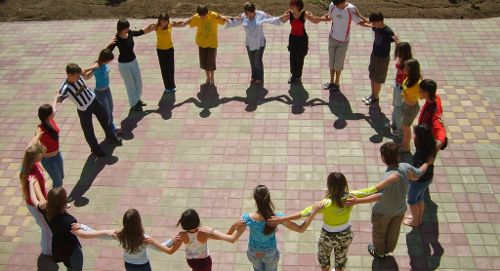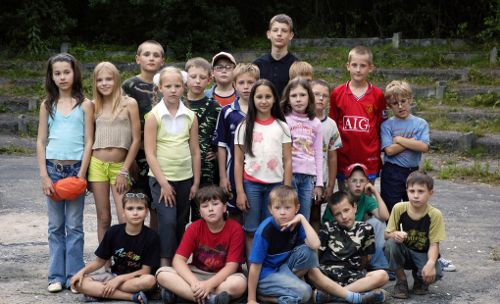Nuclear Contamination
Chernobyl-Affected Zone, Eastern Europe
| Location | Chernobyl-Affect Ares of Ukraine, Belarus, Russia and Ukraine |
|---|---|
| Pollutant | Radioactive waste |
| Cause | Core meltdown at nuclear power plant (NPP) with following explosion and large-scale release of radioactive materials into the environment. |
| Health Impact | The accident took lives of on-site workers and resulted in large-scale relocation of residents in the area. Exposure to radioactive particles caused the development of various types of cancers, genetic changes, and long-term psychological stress and illnesses among nearby residents. A 30-km zone around the former NPP is closed to the public and health-relevant nuclear contaminants will continue to pollute the environment for centuries. |
| Output | Green Cross Switzerland and its local partners in Chernobyl developed and implement a program with medical, psychological, and pedagogical components to improve living conditions of community members, in view that those cannot be relocated. These components include medical clinics, therapy camps, family clubs, and micro-lending programs. |
| Outcome | By 2008 there were 11 family clubs, with a total of over 1,200 members, distributed throughout Belarus, Russia, and the Ukraine. More than 14,600 children have participated in youth therapy camps--in these healthful and comforting surroundings it is typical for their radioactivity exposure levels to drop by 30 to 80 percent. |
| Implications | Therapy camps have proven to be a simple and low-tech mechanism to dramatically reduce the radiation load even in those exposed to a true nuclear catastrophe. This successful approach can now be reapplied at other regions of serious radioactive contamination. The emotional, medical, and financial consolation helps give local communities a sense of hope, which is essential both for fighting off radiation-spawned disease and also for regaining a sense of social normality. |
| Remaining Challenges | Implementing agencies such as Green Cross Switzerland cited challenges in funding programs and alleviating anxiety about public and environmental health in the affected area. |
Context
In the night of 25 to 26 April 1986, the explosion of the NPP’s fourth reactor, the greatest industrial disaster in the history of humankind, released one hundred times more radioactivity than the nuclear bombs dropped over Hiroshima and Nagasaki. Four workers were killed instantly. Four days later, the residents of nearby Pripyat were ordered to evacuate. The residents never returned, and the town remains uninhabited to this day. The NPP is inactive since 12 December 2000, however, a core staff remains on site to service and secure the facility. At the time of the accident, about seven million people lived in the contaminated territories, including three million children. About 350,400 people were resettled or left these areas. However, about 5.5 million people, including more than a million children, continue to live in the contaminated zones.
Radioactive materials cannot be treated, but only become harmless when they have finished their radioactive decay. Because, depending on the material, this can take millennia, these materials must be stored appropriately. There are worldwide efforts to find ways that high-level wastes can be reliably sealed off from the biosphere for at least a million years in so-called final repositories. The issues surrounding the long-term storage of high-level waste are complex and often controversial. Given the levels of hazard involved, this matter is essentially a government responsibility. Selected as one of the 2008 Top Ten Worst Pollution Problems, radioactive waste continues to threaten our world today. In the case of Chernobyl, relevant amounts of nuclear materials have been released into the environment which cannot be recuperated.
Site Details
The Chernobyl area was chosen still in Soviet times as the site of the first NPP on Ukrainian soil. The Chernobyl NPP lies in northern Ukraine, about 7 km from the border with Belarus, while about 120 km to the south lies Kiev, the capital of Ukraine, with a population of about 3 million. Both countries border Poland to the west and Russia to the east.
In addition to the reactor’s immediate surroundings –an area with a radius of about 30 km– other regions were contaminated, particularly in Belarus, Russia and Ukraine, but also as far as Sweden, Western Siberia, and Northern Italy. International estimates suggest that an area up to146,000 km2 extending into Belarus, Russia and Ukraine are contaminated with cesium-137 at levels exceeding 1 curie (Ci) or 3.7 x 1010 becquerel (Bq) per square kilometer (1 Bq corresponds to 1 radioactive decay per second). This is an area greater than that of the neighboring countries of Latvia and Lithuania combined. Most of the contaminated territory lies in Belarus, since up to 70 percent of the total fallout was deposited there. Of the total area of Belarus, 22 percent was contaminated with more than 1 Ci/km2 of cesium-137. In the case of Ukraine, 7.25 percent of the territory was affected, and in the enormous Russian Federation, still 0.6 percent.
Health Impact
The level of radioactive contamination measured does not in itself indicate how much radiation is absorbed by the people living in these areas. The authorities responsible for managing the disaster in the three most affected countries estimate that people living in an area contaminated with 1 to 5 Ci/km2 absorb an average of less then 1.0 millisieverts (mSv) per year (millisieverts (mSv) are the internationally recognized units used to measure the harmful effects of radiation on the human body, i.e., the biologically effective dose). Only when soil contamination is over 5 Ci/km2 are people likely to absorb more than 1 to 5 mSv per year. As a comparison: within the European Union, 1 mSv per year is the dose limit specified for people living near a nuclear power station.
There are widely varying analysis of the long-term health impact by the Chernobyl disaster, mostly reflecting specific agendas. To date, no consensus was found between interest groups. However, people living in contaminated areas have not only an increased chance for developing different pathologies, but suffer also from psychological stress. Passivity and depression are commonly observed in the Chernobyl region.
Exposure Pathways
The main threat is the ingestion of radioactive particles through air, food and water. The most relevant pollutants from a public health perspective are iodine-131, cesium-137, strontium-90, uranium and plutonium. Iodine-131 (a homologue of normal iodine) is readily absorbed by the thyroid gland in case of a lack of naturally occurring iodine, leading to thyroid cancers. Strontium-90 (a homologue of calcium) is readily built into bones, leading to bone cancer or leukemia. Cesium-137 (a homologue to potassium) is built into muscle and tissue, leading to diffuse irradiation of the entire body. Radio-cesium does not as effectively accumulate in the body as radioiodine or radio-strontium. The incorporation of plutonium or uranium might ultimately lead to lung cancer.
Intervention
As it will be impossible to resettle the millions of people living in areas affected by the Chernobyl disaster, the Green Cross interventions aim at improving the living conditions in the villages of Belarus, Ukraine, Russia and Moldova. Green Cross Switzerland, in collaboration with its local partners, has developed over the years a set of medical, psychological and pedagogical interventions:
- Therapy camps: With the aim to strengthen their immune system and mental state, children and youths from Belarus, Russia and the Ukraine spend at least four weeks in camps providing healthy air and food. Medical and psychological care strengthens their immune systems and helps them to develop a more positive life attitude. At the end of the camps, the levels of radionuclides measured in children are typically lowered by 30 to 80 percent. More than 14,600 children and youth have participated in therapy camps since 1996.
- Health preservation: Regular visits by medical staff to the villages help to prevent chronic illnesses, thus avoiding serious impediments in the long term, but also help to assess the long-term efficiency of the measures taken.
- Training for trainers: The training courses for prospective youth-group leaders aim at making youths responsible and knowledgeable so they can pass on their knowledge to others.
- Family clubs: Those are established in villages and serve as a focal point for the population to share problems, learn about how to deal with the contaminated environment (e.g. in food courses teaching how to grow and prepare foodstuff in order to considerably reduce the level of radioactive intake), and facilitate local initiatives. In 2008, 11 family clubs with a total of 1,200 members were active in Belarus, Russia and the Ukraine.
- Micro-credit programs: Support local initiatives through micro-financing, allowing people to build their own small businesses and contribute to the local economic development.
Implementing Organization
Green Cross Switzerland, Green Cross Belarus, Green Cross Russia, Green Cross Ukraine, and Swiss Agency for Development and Cooperation.
Remaining Challenges
Intervention plans must address the complexity of radioactive waste contamination. For instance, they must deal with the immediate needs to clean up sources of contamination and reduce long-term physical and psychological damages to public health. This often entails working with government agencies, public interest groups, and community members. Successful implementation of these programs requires environmental education for the public, active participation, and extensive funding.
References
Green Cross Switzerland. Legacy of the Cold War Programme. Green Cross Switzerland. 2009. 2 Oct. 2009.
→ http://www.greencross.ch/en/projects/legacy/
Swiss Agency For Development and Cooperation. Chernobyl - Tschernobyl - Info. 2009. 2 Oct 2009.
→ http://www.chernobyl.info
Additional Photos
 |
At the end of Therapy Camps, children’s radionuclide levels are typically lowered by 30-to-80 percent. |
 |
Youth from Belarus spend at least 4 weeks in camps which provide healthy air and food. |

-
Phasing Out Leaded Gasoline
-
Ending Chemical Weapons
-
Improving Indoor Air - Ghana
-
Preventing Mining Pollution - Chile
-
Lowering Radioactivity - Chernobyl
-
Cleaning Urban Air - India
-
Removing Lead - Dom. Republic
-
Recapturing Mercury - Indonesia
-
Reducing Lead - Russia
-
Removing DDT - Tanzania
-
Restoring a Waterway - China
-
Removing Arsenic - India



